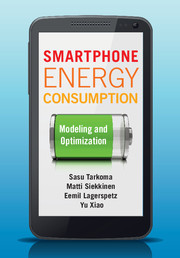Refine search
Actions for selected content:
3527 results in Wireless Communications
16 - Future trends
- from Part III - Advanced energy optimization
-
- Book:
- Smartphone Energy Consumption
- Published online:
- 05 August 2014
- Print publication:
- 07 August 2014, pp 315-323
-
- Chapter
- Export citation
13 - Exploiting multiple wireless network interfaces
- from Part III - Advanced energy optimization
-
- Book:
- Smartphone Energy Consumption
- Published online:
- 05 August 2014
- Print publication:
- 07 August 2014, pp 264-280
-
- Chapter
- Export citation
Frontmatter
-
- Book:
- Smartphone Energy Consumption
- Published online:
- 05 August 2014
- Print publication:
- 07 August 2014, pp i-iv
-
- Chapter
- Export citation
3 - Smartphone batteries
- from Part I - Understanding energy consumption
-
- Book:
- Smartphone Energy Consumption
- Published online:
- 05 August 2014
- Print publication:
- 07 August 2014, pp 36-58
-
- Chapter
- Export citation
15 - Example scenarios for energy optimization
- from Part III - Advanced energy optimization
-
- Book:
- Smartphone Energy Consumption
- Published online:
- 05 August 2014
- Print publication:
- 07 August 2014, pp 297-314
-
- Chapter
- Export citation

Smartphone Energy Consumption
- Modeling and Optimization
-
- Published online:
- 05 August 2014
- Print publication:
- 07 August 2014

Nanotechnologies for Future Mobile Devices
-
- Published online:
- 05 July 2014
- Print publication:
- 11 February 2010

Optimal Combining and Detection
- Statistical Signal Processing for Communications
-
- Published online:
- 05 July 2014
- Print publication:
- 28 January 2010

Microwave and Wireless Measurement Techniques
-
- Published online:
- 05 June 2014
- Print publication:
- 03 October 2013
9 - Positioning without data link: from BGPS to PPP
- from Part III - Mobile positioning at present and in the future
-
- Book:
- GPS, GLONASS, Galileo, and BeiDou for Mobile Devices
- Published online:
- 05 May 2014
- Print publication:
- 15 May 2014, pp 238-273
-
- Chapter
- Export citation
Contents
-
- Book:
- GPS, GLONASS, Galileo, and BeiDou for Mobile Devices
- Published online:
- 05 May 2014
- Print publication:
- 15 May 2014, pp v-xii
-
- Chapter
- Export citation
Part IV - Testing mobile devices
-
- Book:
- GPS, GLONASS, Galileo, and BeiDou for Mobile Devices
- Published online:
- 05 May 2014
- Print publication:
- 15 May 2014, pp 291-292
-
- Chapter
- Export citation
About this book
-
- Book:
- GPS, GLONASS, Galileo, and BeiDou for Mobile Devices
- Published online:
- 05 May 2014
- Print publication:
- 15 May 2014, pp xix-xix
-
- Chapter
- Export citation
11 - Testing equipment and procedures
- from Part IV - Testing mobile devices
-
- Book:
- GPS, GLONASS, Galileo, and BeiDou for Mobile Devices
- Published online:
- 05 May 2014
- Print publication:
- 15 May 2014, pp 293-310
-
- Chapter
- Export citation
Index
-
- Book:
- GPS, GLONASS, Galileo, and BeiDou for Mobile Devices
- Published online:
- 05 May 2014
- Print publication:
- 15 May 2014, pp 311-312
-
- Chapter
- Export citation
List of abbreviations and acronyms
-
- Book:
- GPS, GLONASS, Galileo, and BeiDou for Mobile Devices
- Published online:
- 05 May 2014
- Print publication:
- 15 May 2014, pp xxi-xxiv
-
- Chapter
- Export citation
8 - Positioning with data link: from AGPS1 to RTK
- from Part III - Mobile positioning at present and in the future
-
- Book:
- GPS, GLONASS, Galileo, and BeiDou for Mobile Devices
- Published online:
- 05 May 2014
- Print publication:
- 15 May 2014, pp 207-237
-
- Chapter
- Export citation
4 - Referenced positioning with GNSS
- from Part I - GNSS: orbits, signals, and methods
-
- Book:
- GPS, GLONASS, Galileo, and BeiDou for Mobile Devices
- Published online:
- 05 May 2014
- Print publication:
- 15 May 2014, pp 110-128
-
- Chapter
- Export citation
1 - GNSS ground and space segments
- from Part I - GNSS: orbits, signals, and methods
-
- Book:
- GPS, GLONASS, Galileo, and BeiDou for Mobile Devices
- Published online:
- 05 May 2014
- Print publication:
- 15 May 2014, pp 3-38
-
- Chapter
- Export citation
Part I - GNSS: orbits, signals, and methods
-
- Book:
- GPS, GLONASS, Galileo, and BeiDou for Mobile Devices
- Published online:
- 05 May 2014
- Print publication:
- 15 May 2014, pp 1-2
-
- Chapter
- Export citation
